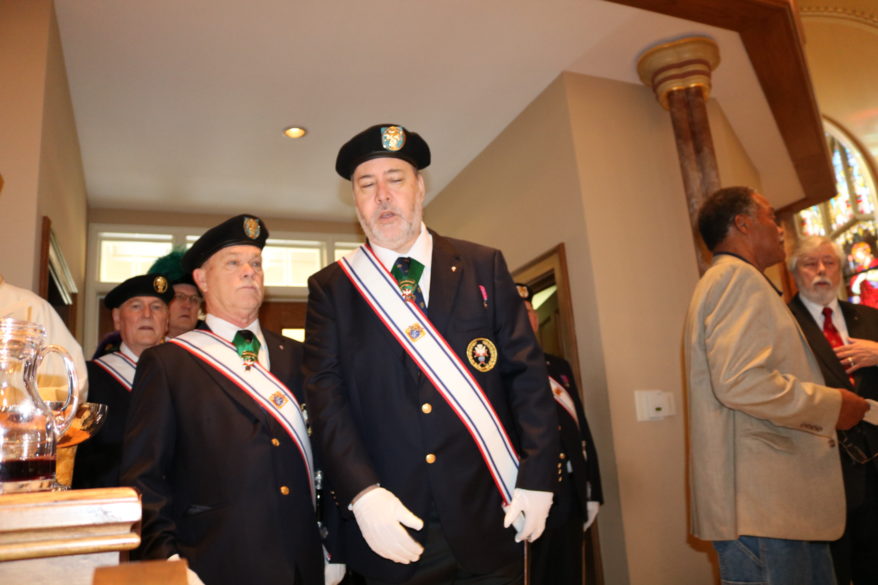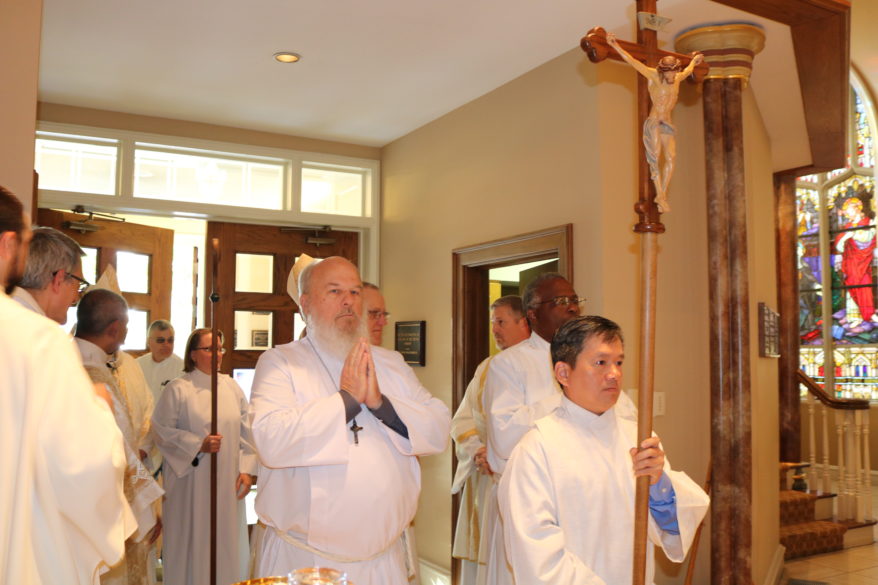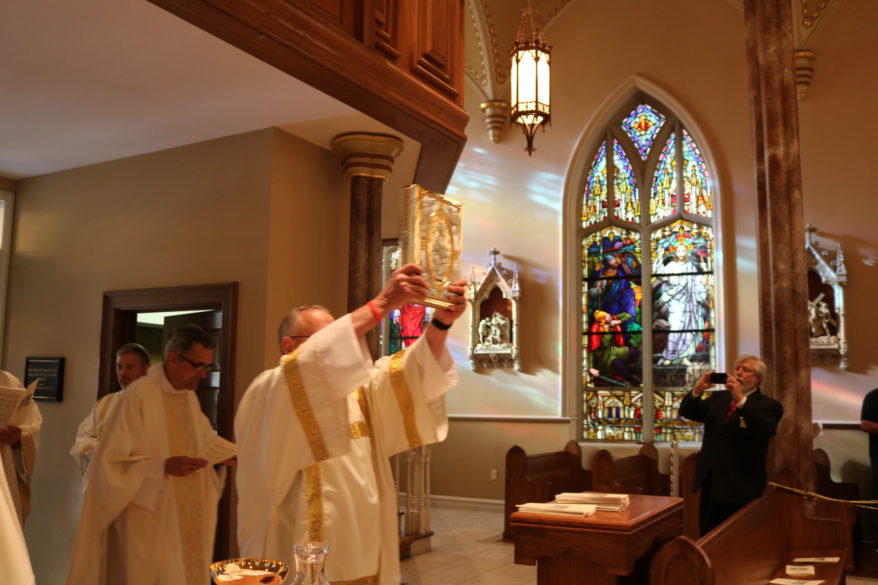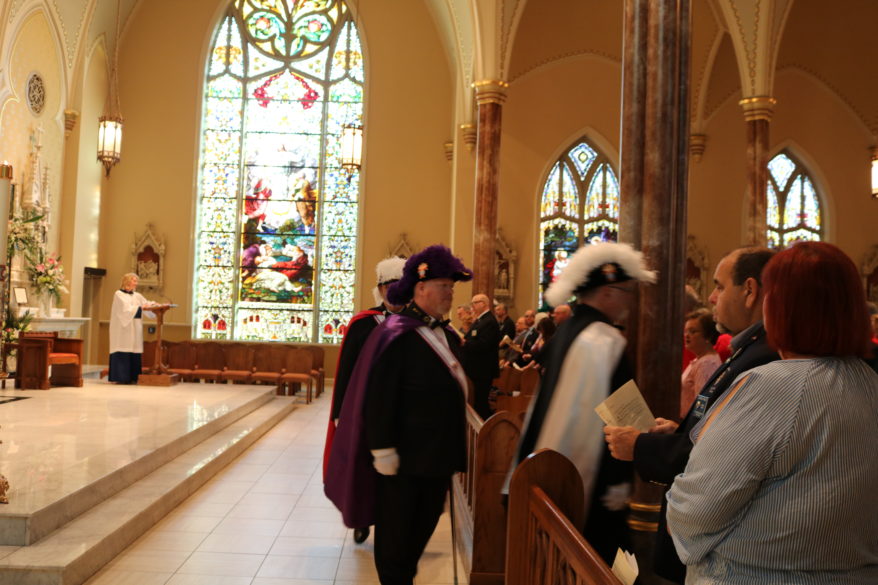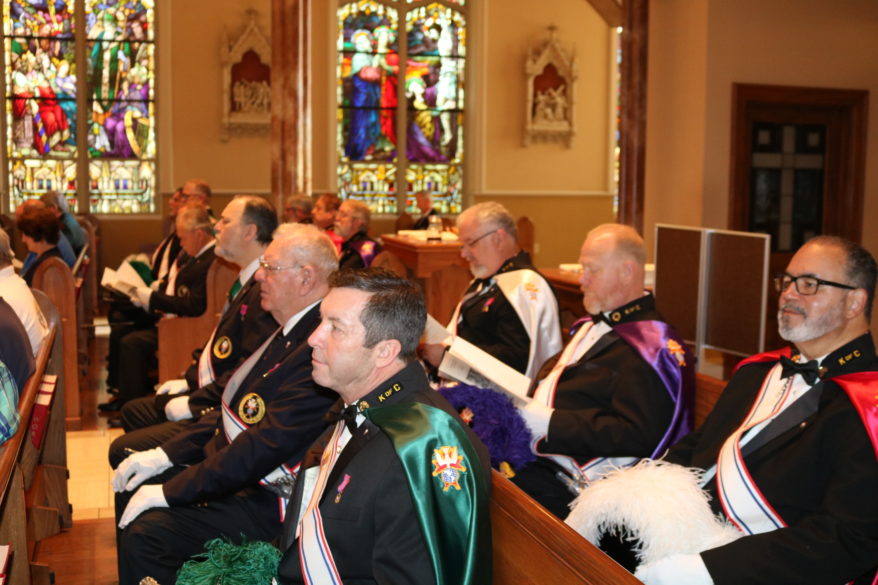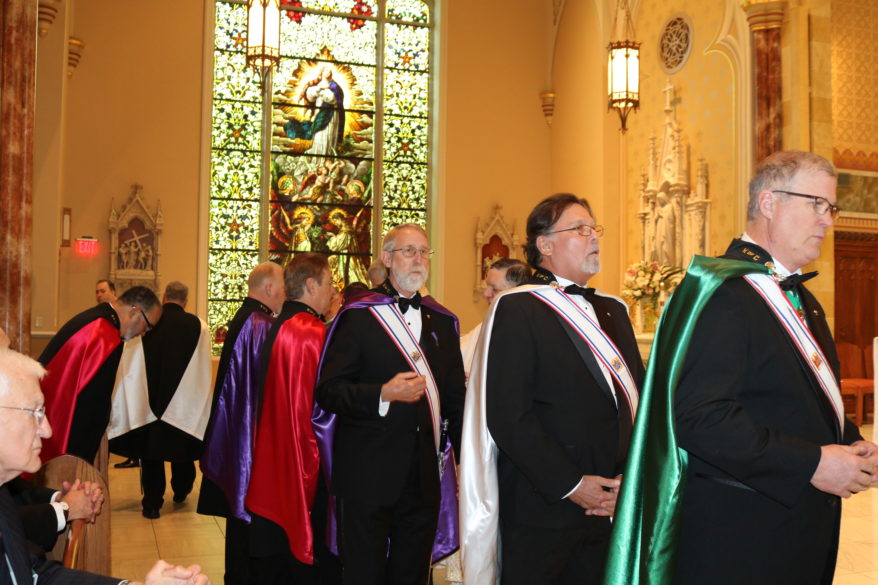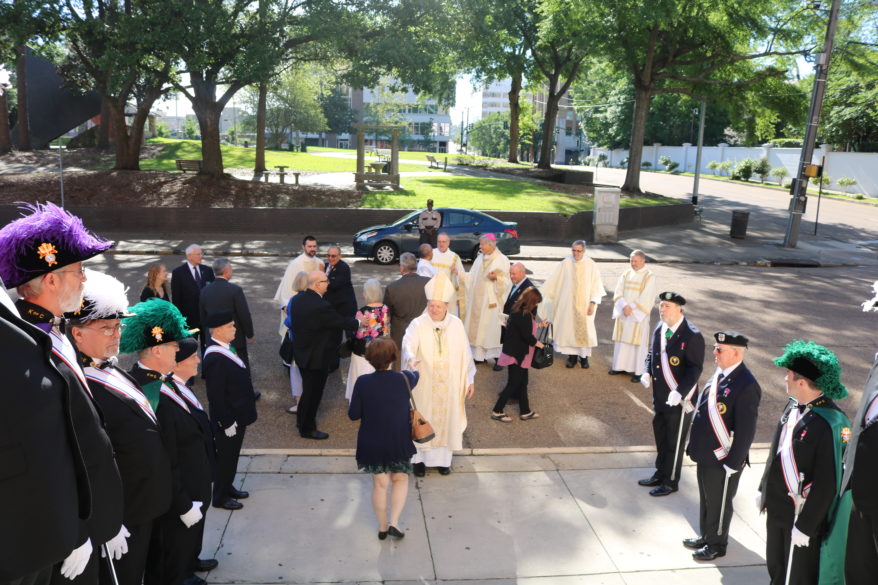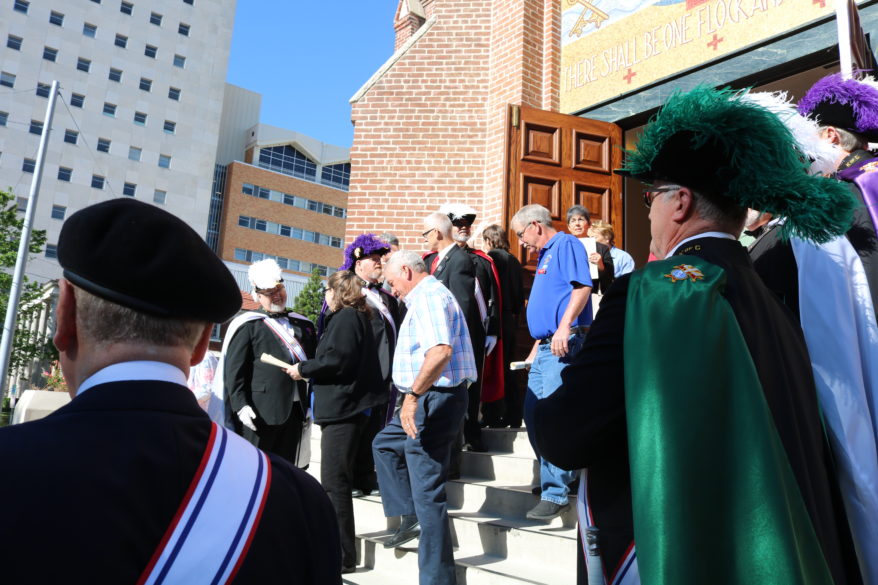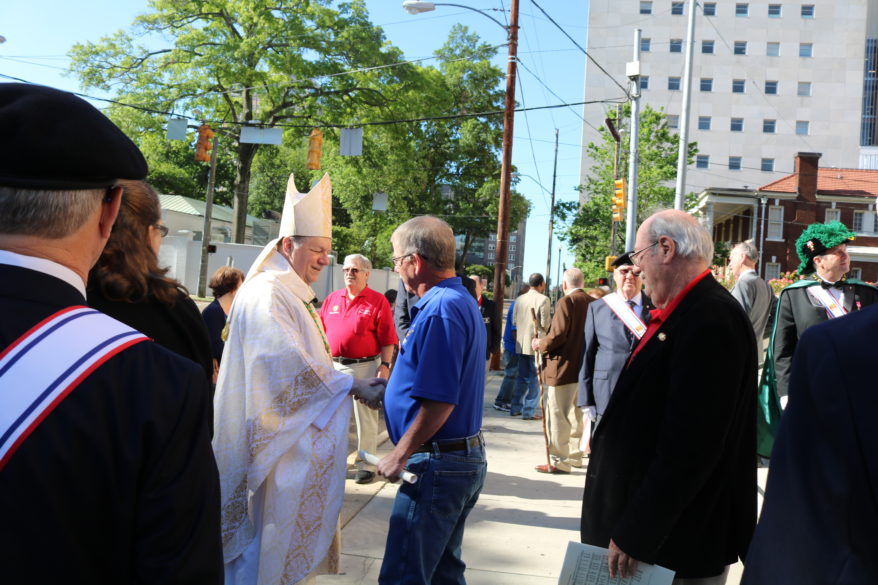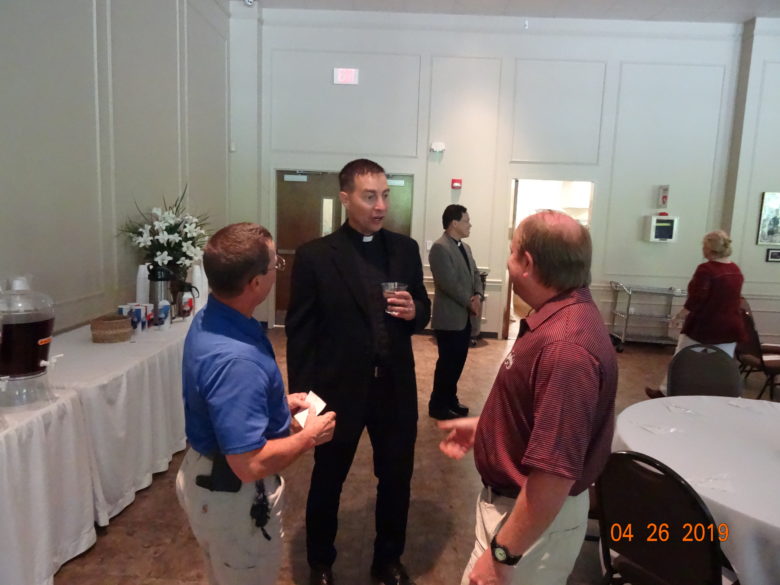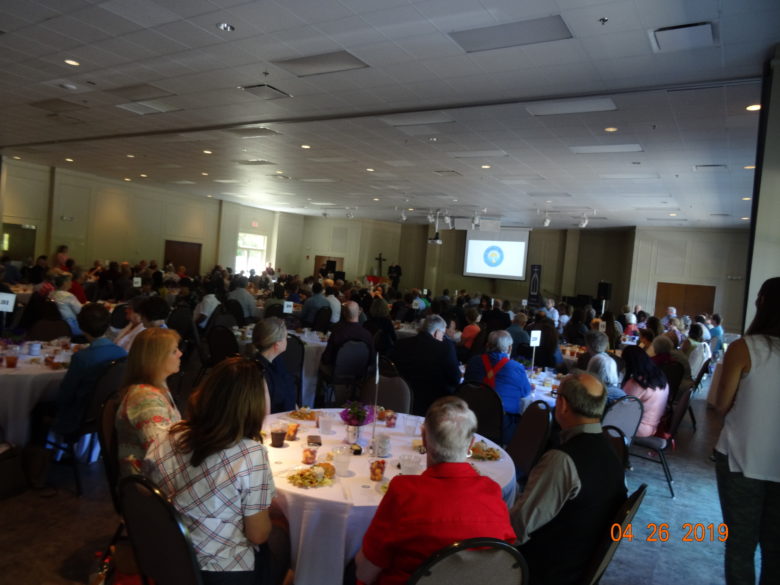JACKSON – The Mississippi Knights of Columbus held their annual convention in Jackson the last weekend of April with the theme “In solidarity with our Church.” The gathering gives the knights a chance to share ideas, receive training and recognize those councils and individuals who have offered exemplary service. Mississippi Knights raised more than $85,000 to support seminarians and pro-life initiatives this year. More than 300 people attended.
All photos are from the Mass Bishop Louis Kihneman of the Diocese of Biloxi celebrated at the Cathedral of St. Peter the Apostle on Saturday, April 27.
Here are some highlights of those honored during the convention:
Knight of the Year: Norman J. Cantrelle – Most Holy Trinity Council 11995 in Pass Christian
Sir Knights of the Year: Sir Knight David Fisher, Assembly 554 Jackson and Sir Knight Stephen D’Angelo, Assembly 3625 Pass Christian.
Assembly of the Year: Bishop Gerow Assembly 554 – Jackson
Worthy Marshal of the Year: Sir Knight Craig Harrell, Worthy Marshal District 8
Family of the Year: Willie B. Jones Family -Most Holy Trinity Council 11995 in Pass Christian
Best Faith Program: Council 848; Cathedral of St. Peter the Apostle Council; Jackson for the Refund Support Vocation Program (RSVP)
Best Family Program: Council 1522; Pere Le Duc Council; Bay St. Louis for the Our Lady of the Gulf Parish Picnic
Best Community Program: Council 898; Vicksburg Council for Meals on Wheels for the Homebound
Best Life Program: Council 10901; St. John Council; Oxford for BBQ Dinner Fundraiser for Pregnancy Center
Best Vocations Programs: Jackson Diocese – Council 848; Cathedral of St. Peter the Apostle Council; Jackson for work with Carmelite Sisters and Monastery
Biloxi Diocese: Council 16433; St. Clare Council; Waveland for Cycle to Saints.
Author Archives: Tereza Ma
Jesus makes us young, new, full of life
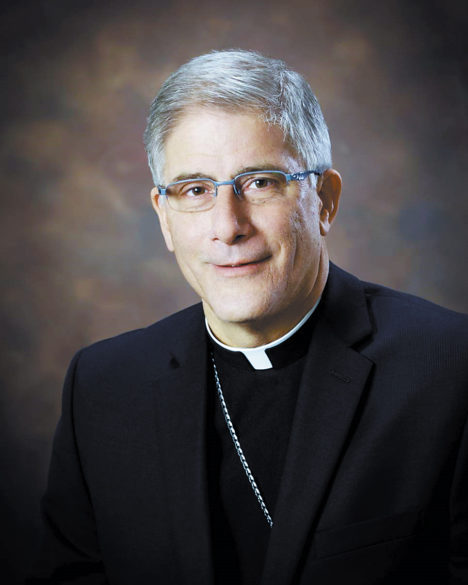
By Bishop Joseph Kopacz
In the fourth Gospel and in his letters the beloved disciple, Saint John, returns repeatedly to his bold proclamation that “God so loved the world that he gave his only Son so that the world might be saved through him.” (John 3,15) As in the Synoptic Gospels of Matthew Mark and Luke the Lord’s death on the Cross is the fulfillment of this eternal love where Saint John portrays the blood and water flowing from the side of the crucified beloved Son of God. These sacred streams became the dual fountains of new life in the Church in the saving waters of Baptism and in the new covenant of his blood each time the Mass is offered and celebrated.
In his document, Christus Vivit, to young people and to the entire people of God, fresh off on the press on March 25, the feast of the Annunciation, Pope Francis boldly proclaims that because God so loved the world, “Jesus Christ is alive, and he wants you to be alive! He is our hope, and in a wonderful way he brings youth to our world, and everything he touches becomes young, new and full of life.” On each sacred occasion when we celebrate the sacraments of Baptism and the Eucharist during the Easter season which began on Easter Sunday and will culminate at Pentecost 50 days later, the Lord Jesus goes about his saving work of making the world young, new and full of life. On the second and third Sundays of this Easter season we proclaimed the resurrection appearances from Saint John that reveal the personal and universal plan of salvation. In the creation story of Genesis God formed man and woman from the earth’s elements and breathed into them the breath of life, and we became living beings. (Genesis Ch. 2)
To the apostles huddled in fear, (J0hn 20,19ff) the risen Lord bathed them in peace and breathed upon them the creative and reconciling love of the Holy Spirit. “As the Father has sent me, so I send you.” In particular the Lord encountered Thomas, broken in spirit and overwhelmed by doubts that had broken the back of his faith. Jesus restored him to life through the touch of his wounds and the sound of his voice.
In last Sunday’s Gospel Jesus appeared to several of the Apostles at the sea of Galilee who had returned to their former lives after the crucifixion, among whom were Peter, Thomas and John. Jesus was waiting for them at the shore after guiding them to another successful catch that could barely be contained – 153 in all. This number represents God’s universal plan to bring the Gospel to all the known nations of that time. From the universal to the personal, now it was Peter’s turn to be reconciled and restored. (John 21,1ff) As they gathered around the fire for breakfast, the memory of the fire in the courtyard had to be weighing on Peter when he vehemently denied that he knew his Savior. Then, it was night. Jesus had gazed at Peter in that moment and remembering the Lord’s prediction at the Last Supper, Peter went out and wept bitterly.
But now it is the dawning of a new day, and with the fire between them for a second time, Jesus gazed on Peter with the warmth of his love and asked three times, “do you love me?” There was no reproach in the words and tone of Jesus to Peter, to Thomas or to any of his apostles for their behavior during the time of his suffering and death, but rather a deep desire to restore them to life in his name in order to launch the Gospel to the ends of the earth. The rest is history.
Peter fulfilled his destiny as the leader of the early Church, and Thomas brought the Good News to the realm of India. God so loves the world that this eternal question is directed to each of us who disciples of his beloved son are. Do we love him? In Christus Vivit Pope Francis quotes the poetic words of Pedro Arrupe, the legendary Jesuit Superior. “Nothing is more practical than finding God, than falling in love in a quite absolute, final way. What you are in love with, what seizes your imagination, will affect everything. It will decide what will get you out of bed in the morning, what you will do with your evenings, how you will spend your weekends, what you read, whom you know, what breaks your heart, and what amazes you with joy and gratitude. Fall in love, stay in love and it will decide everything.” This love for God is possible thanks to the Holy Spirit who raised Jesus from the dead.
Writing nearly three generations after the death and resurrection of Jesus, Saint John ends his gospel with words of enduring love, hope and light for all people for all time. “Now Jesus did many other signs in the presence of his disciples that are not written in this book. But these are written that you might come to believe that Jesus is the Messiah, the Son of God, and that through this belief you may have life in his name.” (John 20, 30-31).
“Dios amó tanto al mundo que dió a su Hijo”

Por Obispo Joseph Kopacz
En el cuarto Evangelio y en sus cartas, el amado discípulo, San Juan, vuelve repetidamente a su audaz proclamación que “Dios amó tanto al mundo que dio a su Hijo único para que todo aquel que cree en él no muera, sino que tenga vida eterna “ (Juan 3,15-16).
Como en los evangelios sinópticos de Mateo, Marcos y Lucas, la muerte del Señor en la Cruz es la realización de este amor eterno donde San Juan retrata la escena de la sangre y el agua que fluyen del costado del amado Hijo de Dios crucificado.
Estos dos torrentes sagrados se convirtieron en las fuentes duales de una nueva vida en la Iglesia, en las aguas salvadoras del Bautismo y en el nuevo pacto a través de su sangre, cada vez que se celebra la Misa.
En su documento, Christus Vivit , a los jóvenes y al pueblo de Dios, recién publicado en la prensa el 25 de marzo en la fiesta de la Anunciación, el Papa Francisco proclama valientemente que debido a que Dios amó al mundo, “…Jesucristo está vivo, y Él quiere que estés vivo! Él es nuestra esperanza, y de una manera maravillosa trae jóvenes a nuestro mundo, y todo lo que Él toca se vuelve joven, nuevo y lleno de vida”.
En cada ocasión sagrada, cuando celebramos los sacramentos del Bautismo y la Eucaristía durante la temporada de Pascua, que comenzó el domingo de Pascua y culminará en Pentecostés, 50 días después, el Señor Jesús se ocupa de salvar al mundo joven, nuevo y lleno de vida.
En el segundo y tercer domingo de esta temporada de Pascua, proclamamos las apariciones de resurrección de San Juan que revelan el plan personal y universal de salvación.
En la historia de la creación de Génesis, Dios formó al hombre y la mujer a partir de los elementos de la tierra y sopló en ellos el aliento de la vida, y nos convertimos en seres vivos. (Génesis Capítulo 2). A los apóstoles acurrucados de miedo, (Juan 20,19 en adelante) el Señor resucitado los bañó en paz y les dio el amor creativo y reconciliador del Espíritu Santo. “Como el Padre me envió, también yo os envío”. En particular, el Señor se encontró con Tomás con el espíritu indispuesto y abrumado por las dudas que habían roto la columna de su fe. Jesús lo devolvió a la vida a través del toque de sus heridas y con el sonido de su voz.
En el Evangelio del domingo pasado, Jesús se apareció a varios de los apóstoles en el mar de Galilea, adonde habían regresado a sus vidas anteriores después de la crucifixión, entre los cuales se encontraban Pedro, Tomás y Juan.
Jesús los estaba esperando en la orilla después de guiarlos a otra captura exitosa que apenas podía contener 153 en total. Este número representa el plan universal de Dios para llevar el Evangelio a todas las naciones conocidas de ese tiempo. De lo universal a lo personal, ahora fue el turno de Pedro de reconciliarse y restaurarse. (Juan 21,1 y en adelante).
Mientras se reunían alrededor del fuego para desayunar, la llama debió traer a Pedro el recuerdo de cuando negó con vehemencia que conocía a su Salvador. Entonces, era de noche. Jesús había mirado a Pedro en ese momento y recordando la predicción del Señor en la última cena, Pedro salió y lloró amargamente. Pero ahora es el amanecer de un nuevo día, y con el fuego entre ellos por segunda vez, Jesús miró a Pedro con la calidez de su amor y le preguntó tres veces: “¿Me amas?” No hubo reproche en sus palabras ni en el tono de Jesús a Pedro, a Tomás o a cualquiera de sus apóstoles por su comportamiento durante el tiempo de su sufrimiento y muerte, sino más bien un profundo deseo de devolverles la vida en su nombre para lanzar el Evangelio hasta el fin de la tierra.
El resto es historia. Pedro cumplió su destino como líder de la Iglesia primitiva, y Tomás trajo la Buena Nueva al reino de la India. Dios ama tanto al mundo que esta pregunta eterna está dirigida a cada uno de nosotros, discípulos de su hijo amado. ¿Lo amamos?
En Christus Vivit, el Papa Francisco cita las palabras poéticas de Pedro Arrupe, el legendario Superior jesuita. “ ¡Enamórate! (o déjate enamorar), porque «nada puede importar más que encontrar a Dios. Es decir, enamorarse de Él de una manera definitiva y absoluta. Aquello de lo que te enamoras atrapa tu imaginación, y acaba por ir dejando su huella en todo. Será lo que decida qué es lo que te saca de la cama en la mañana, qué haces con tus atardeceres, en qué empleas tus fines de semana, lo que lees, lo que conoces, lo que rompe tu corazón y lo que te sobrecoge de alegría y gratitud. ¡Enamórate! ¡Permanece en el amor! Todo será de otra manera”Este amor por Dios es posible gracias al Espíritu Santo que resucitó a Jesús de entre los muertos.
Escribiendo casi tres generaciones después de la muerte y resurrección de Jesús, San Juan termina su evangelio con palabras de amor perdurable, esperanza y luz para todas las personas y por siempre. “Jesús hizo muchas otras señales milagrosas delante de sus discípulos, las cuales no están escritas en este libro. Pero estas se han escrito para que ustedes crean que Jesús es el Mesías, el Hijo de Dios, y para que creyendo tengan vida por medio de Él.”(Juan 20, 30-31).
Christus Vivit: encounter, empower, listen

Kneading faith
By Fran Lavelle
“Be who God meant you to be and you will set the world on fire.” St. Catherine of Siena. This quote and indeed this saint have been on my mind a lot lately. Perhaps it’s because our calling to be who God intends us to be is particularly poignant during the Easter Season. Graduations are beginning to happen in our high schools and universities; we are in full swing Confirmation mode; and, by Jesus’ resurrection we see our hope and promise is renewed. For the youth in our midst, who are you meant to be?
The past few weeks I have spent some quality time with Pope Francis’ Papal Apostolic Exhortation, Christus Vivit, to the young people of the world. In October of 2018, the XV Ordinary General Assembly of the Synod of Bishops convened to discuss “young people, the faith and vocational discernment.” Christus Vivit is derived from those proceedings. Having spent the better part of my ministry serving God’s young people, I have found this document to be affirming and challenging.
Defining youth, as in who is and who isn’t a youth, especially in ministry, is kind of tricky. The definition of young people included in the Synod and subsequentially Christus Vivit is 16-29. The defined age group was not considered as a homogeneous unit, rather seen as a heterogeneous group made up of various cultural realities and experiences of young people around the world. The study group included young people born between 1989 and 2002. They are defined by social scientists as Generation Y or Millennials (born 1980 to 2000) and Generation Z (born 2000 to present). Pope Francis paid great attention to the diversity of experiences and culture within this broad age group.
Using the Scriptures and the canon of saints, Pope Francis connects the lives of young people with the lives of other virtuous young people throughout the ages. He takes the approach of looking back to look forward and empower our youth today. He makes it very clear that young people are not the future of our world, but its present. Sometimes we get caught up as pastors, catechetical leaders and parents in thinking that young people are the future of the Church. Without acknowledging them now, understanding their culture, and recognizing their gifts, we can rest assured that they will be unchurched in the future.
One of the primary areas the Synod addressed that Pope Francis asks us to encounter in a serious way is our digital environment. The internet and social media have myriad implications on several levels. It effects individual development of social norms and skills, it creates anonymity which fosters an environment of bullying and other negative behaviors, it creates a false sense of self, self-image and self-worth, both in narcissistic and self-loathing ways.
While these mediums were created to bring the world closer and have great potential and capacity for good, the reality is the digital environment has also created a rootlessness and loneliness. It is our challenge to continue to be a virtual space that is rooted in the Gospel and builds healthy communities for young people to flourish.
My favorite might be the chapter devoted to youth ministry. He begins by underscoring his core belief that young people themselves are agents of youth ministry. He recognizes the need for adult guidance but at the same time affirms that young people need to be free to develop new approaches. He does not advocate throwing out everything from the past; rather, he is asking us to examine what has worked and been effective. In doing so, we are challenging ourselves reevaluate what has proved to be effective in communicating the Gospel.
Youth ministry, Francis maintains, has two main functions; one is outreach and the other is growth. Outreach reflects how we are attracting youth to the Gospel. Growth is how we invite those who have experienced the Gospel to learn how to deepen in that experience and mature in it. It is quite clear that Pope Francis recognizes that young people are to be empowered. They are built for community. They are hungry to be seen, heard and valued. The language young people understand, the pope maintains, is the language spoken by those who “radiate life” by those who are there with them and for them.
The Pope is writing this for all of us, not just the youth of the Church. Our ability to radiate life regardless of our role, title or ministry is at the core of how we are to be as Catholic Christians. Not just for our youth, but for all of God’s people, let us be present to one another with the care, compassion and love Jesus has for each one of us. Now, let’s go set the world on fire!
(Fran Lavelle is the Director of Faith Formation for the Diocese of Jackson.)
Sing to the Lord: music within liturgy
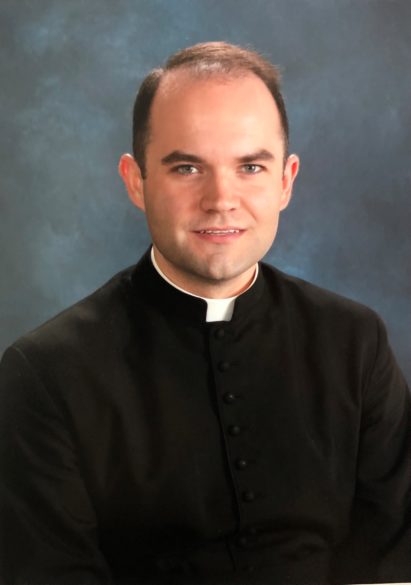
SPIRIT AND TRUTH
By Father Aaron Williams
In my last column, I discussed the vision of the Second Vatican Council in regard to the active participation of the laity in the Sacred Liturgy. I mentioned that the first time this term was used in a papal document was in 1903 when Pope Saint Pius X proposed the idea in the context of speaking about the role of music in the liturgy. I would like to expand that thought now by considering what the Second Vatican Council proposed as the stand of liturgical music.
Speaking on this topic, the Council Fathers said, “The musical tradition of the universal Church is a treasure of inestimable value, greater even than that of any other art. The main reason for this pre-eminence is that, as sacred song united to the words, it forms a necessary or integral part of the solemn liturgy.” This statement needs to be carefully considered. The Council proposes that music is “integral” to the liturgy itself. In other words, it is no mere ornament or decorative element to liturgical act. We Catholics are not called to sing “at” Mass — as if the Mass was some gathering within whose context we burst into song. Rather, we are called to sing “the” Mass.
What does that mean? The post-conciliar document, Musicam Sacram, which remains today the most authoritative Church document on sacred music, gives a pretty firm recommendation in how music is to be incorporated in the liturgy. In fact, it gives three degrees of sacred music in the Mass — numbering them according to importance as to what should one sung. First among this list is the dialogues between the priest and the people. That may seem odd to us. We might imagine the Church desires some sort of hymn be sung before anything else. In fact, in our common experience, we usually associate the priest chanting the dialogues or the prayers as something reserved to really solemn occasions.
The Church, however, sees things a little differently. The dialogues between the priest and the people, the prayers, the preface — these elements constitute the most important parts of the Mass. They are the parts of the Mass where we take our true role as the members of Christ’s Mystical Body. It is fitting, therefore, if these are the moments when we are most participating in the liturgy, that these are the first to be considered when finding the place of music in the liturgy.
In my own practice, I have developed a custom of always chanting the principal dialogues and prayers at the main Sunday Mass when I am the celebrant. I know other priests that do this at all Sunday Masses, and some even on weekdays. By elevating these texts into song, we further unify our voices as one expression of Christ’s body — not only joining in word, but also in tone, and meter, and expression.
The second elements are those parts of the Mass which are unchanging, or what the Church calls the “ordinary” (the Kyrie, Gloria, Creed, Sanctus, and Agnus Dei). Most of these parts of the Mass are normally sung in most parishes, so I don’t think much needs to be said other than that since they are unchanging it is much easier for parishes to memorize settings of the Mass ordinary for singing, thus furthering their ability to truly participate in these acts.
Finally, there is the proper. Most people have no experience of the sung proper. At daily Masses in some parishes, people will experience the antiphons spoken from a missallete. These antiphons are intended to actually be sung, especially in more solemn Masses, and are what the Church calls the “proper” of the Mass. In our ordinary experience, the vast majority of parishes substitute the proper antiphons for hymns (which are rooted in a vastly Lutheran/Anglican/Methodist tradition). While this is certainly permitted by the liturgy, the ideal proposed by the Council Fathers was that the proper of the Mass be truly sung.
I will use the second Sunday of Easter as an example. The Gospel that day was about St. Thomas coming to believe in the Resurrection when Christ says to him, “Bring your hand and feel the place of the nails.” The Church, desiring us to make a connection between the risen flesh of Christ in the Gospel and the real presence of Christ in the Eucharist, encourages us to take these same words upon our lips as we approach the altar. The Communion antiphon that day is, “Bring your hand and feel the place of the nails, and do not be unbelieving but believing, alleluia.”
In most places, this text was probably not even considered and was replaced by a eucharistic hymn, but by doing so we are replacing parts of the Mass which, like the readings themselves, the Church offers for our own spiritual nourishment. Though there isn’t space to go into all the various options for how these propers may be sung, suffice it to say there are a plethora of resources available readily online for free which can enable any parish to begin approaching this goal.
(Father Aaron Williams is the parochial vicar at Greenville St. Joseph Parish and serves as the liaison to seminarians for the Office of Vocations.)
Parish calendar of events
SPIRITUAL ENRICHMENT
BATON ROUGE Louisiana, WINE (Women in the New Evangelization) Conference “Beautifully United in Spirit” Saturday, July 27, 8:30 a.m. – 3 p.m. at Our Lady of the Holy Rosary Church, St. Amant, Louisiana. Emcee Karen Sheehy Catholic author and WINE Specialist. Keynote speakers Kelly Wahlquist, WINE foundress, Catholic author and inspirational speaker, Teresa Tomeo, syndicated talk show host, author, and motivational speaker and Catholic evangelist, retreat director and radio host and Gloria Purvis Catholic advocate, speaker, and radio host. Join women from around the country for a day of inspiration, faith, fellowship and fun. Event price: $55 early bird price before June 27, $65 after June 27. Special price for religious sisters, consecrated women and students. Details: https://beautifullyunitedla.eventbrite.com to register or email karen@spiritualsafariguide.com.
BROOKSVILLE The Dwelling Place, Not Seeing Eye-to-Eye with Jesus, June 14-16. Do I think Jesus sees me the way I see myself? If not, is the difference important to me? Do I want to see myself as Jesus sees me? Conversion happens only when this change in seeing occurs. Presenter: Father Henry Shelton, retired priest of the diocese, who has conducted many seminars and retreats in Mississippi and surrounding states. Begins with dinner on Friday at 6:30 p.m. and concludes with lunch at noon on Sunday. Donation: $200. Details: (662) 738-5348 or email dwellpl@gmail.com.
CHATAWA St. Mary of the Pines Retreat Center, “With Burning Hearts” Henri J.M. Nouwen’s meditative book, June 16-22. We read in the Emmaus story “Did not our hearts burn within us?” Both sources, contemporary writers and Sacred Scripture, will form the basis for reflection on Eucharist as sacrament and way of life. Begins with dinner on Sunday and concludes with breakfast on Saturday. Presenter: Sister Kate DuVal, SSND. Suggested donation: $450. Details: Sister Sue Von Bank (601) 783-0801 or retreatcenter@ssndcp.org.
CULLMAN, Ala., Benedictine Sisters Retreat Center, Letting Go and Letting God: The Wisdom of Twelve-Step Spirituality, Saturday, June 22, 9:30 a.m. – 4 p.m. Letting God’s will and loving care uphold and direct our lives requires an ever-deepening process of surrender that is described in all genuine spiritual traditions yet uniquely articulated through the Twelve Steps of Alcoholics Anonymous. This reflection day will focus on the core principles of Twelve-Step Spirituality and the gift of spiritual freedom that is experienced when these principles are put into practice. Retreat Director: Sister Therese Haydel, O.S.B. Cost: $30, includes lunch. Details: (256) 734-8302, retreats@shmon.org or www.shmon.org.
PARISH, SCHOOL AND FAMILY EVENTS
CLEVELAND Our Lady of Victories, “Life After Loss: An Invitation” from 12-1 p.m. (bring your lunch) led by Larry L. Lambert, LPC. Remaining dates and topics on Wednesdays, May 15: Telling my story – struggling to hold on and to move on; May 22: A new day, a different world – distressing emotions and stressing demands; May 29: Where do I go from here? Renewed direction and enthusiasm and June 5: Learning to trust in a good future. Sessions are free and open to all. Details: (662) 719-8756 or email lamb5999@bellsouth.net.
HERNANDO Holy Spirit, Weight Loss Support Group, Tuesdays at 9 a.m. Come join each week as we support each other on our weight loss journey and strive to become healthier, happier persons. Details: Liz Brown at (901) 331-3419.
NATCHEZ St. Mary Basilica, Adult Sunday School, Queen of Heaven: Mary’s Battle for Souls”, DVD series from Saint Benedict Press, Sundays at 8:30 a.m. in the conference room of the Family Life Center. Details: Karen Verucchi, Class facilitator at (601) 870-5388.
YOUTH BRIEFS
GREENVILLE St. Joseph, Vacation Bible School, June 10-13, 9 a.m. – noon in the Parish Hall for children ages 4-12 years old. Workers are needed. Details: church office (662) 335-5251.
HERNANDO Holy Spirit, Vacation Bible School, June 17-21, 6 – 7:30 p.m. See your Holy Happenings for volunteer sheet. Details: Allison Baskin at (901) 409-1038.
LELAND St. James, Ladies Lunch Bunch, Wednesday, May 15, at the Mexican restaurant on Highway 82 at noon. Details: Call Patricia Maugh at (662) 379-0615 or Anita Minton at (662) 822-1775 for reservations.
MERIDIAN Catholic Community of St. Joseph and St. Patrick, First Family Dodgeball Championship, Sunday, May 19 at 1 p.m. in St. Patrick Family Life Center. Family teams of 4-6 persons will compete for a trophy. Registration fee is $5. Details: Adrian at (601) 917-4566.
NATCHEZ St. Mary Basilica, Vacation Bible School, June 10-14, 5:30 – 8:30 p.m. in the Family Life Center. This time set is different from past years. Eight to 10 adult volunteers are needed. Details: Regina at the church office (601) 445-5616.
Magistrate denies motion to dismiss charges against plowshares activists
By Dennis Sadowski
WASHINGTON (CNS) – A federal magistrate judge denied motions from seven longtime Catholic peacemakers to have charges dismissed on religious freedom grounds in connection with their April 2018 protest at an East Coast submarine base.
Magistrate Judge Benjamin Cheesbro of the Southern District of Georgia said in an April 26 ruling that the defendants, all Catholics, failed to show that the government violated their rights under the Religious Freedom Restoration Act.
In an 80-page ruling, Cheesbro determined that while the cause the activists espoused is legitimately religious and their faith is sincere, the 20-year prison term that the seven face was the government’s least coercive response to the protest.Bishop Joseph Kopacz testified on behalf of the protestors on Nov. 7 of last year.
Cheesbro said the faith-based activists could have pursued other means to carry out their protest against nuclear weapons on religious grounds rather than illegally entering the Naval Submarine Base Kings Bay in Georgia.
Cheesbro also denied the defendants’ three other legal arguments for dismissal, saying that the federal government acted appropriately in charging them with conspiracy, destruction of property, depredation of government property and trespass in connection with the Kings Bay Plowshares action on the night of April 4-5, 2018.
Bill Quigley, a law professor at Loyola University New Orleans who is pro bono legal representative for the seven, told Catholic News Service April 29 that an appeal of Cheesbro’s decision would be filed with the U.S. District Court for Southern Georgia within 30 days of the ruling.
“We think he was at least half right, that our people are sincere, they were motivated by deep religious, Catholic faith and the opposition to nuclear weapons is a key part of Catholic faith,” Quigley said of Cheesbro’s ruling.
“We disagree with the idea that it’s appropriate that the least restrictive means for the government to address people’s religious belief is by exposing them to 20-plus years in prison. That’s going to be one of the key challenges we bring (in the appeal),” Quigley explained.
The defendants, all Catholics, include Elizabeth McAlister of Baltimore; Jesuit Father Steve Kelly of the Bay Area in California; Carmen Trotta of New York City; Clare Grady of Ithaca, New York; Martha Hennessy of New York, granddaughter of Catholic Worker co-founder Dorothy Day; Mark Colville of New Haven, Connecticut; and Patrick O’Neill of Garner, North Carolina.
Father Kelly, McAlister and Colville remain jailed in Georgia, while the four others have been released on bond.
The protest marked the 50th anniversary of the assassination of the Rev. Martin Luther King Jr. and to “repent of the sin of white supremacy that oppresses and takes the lives of people of color here in the United States and throughout the world.”
The seven entered the submarine base, the East Coast home of the Trident nuclear submarine, and during approximately two hours placed crime scene tape and spilled blood at different locales while posting an “indictment” charging the military with crimes against peace, citing the Nuclear Non-Proliferation Treaty.
The Navy’s fleet of Trident submarines carries about half of the U.S. active strategic nuclear warheads, according to military experts.
In their arguments, the activists sought dismissal of the charges on grounds that they were being selectively prosecuted, that the charges were “duplicitous and multiplicitous,” that the government failed to identify an offense under international and domestic law, and that they were being unlawfully prosecuted under the Religious Freedom Restoration Act.
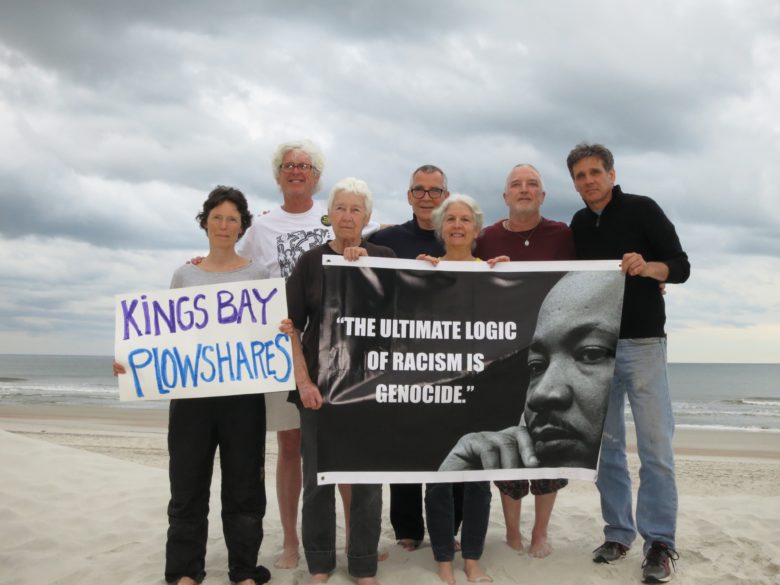
Father Masters’ returns for Journey of Hope in Tupelo
By Maureen Smith
TUPELO – Almost 300 people attended a Journey of Hope Luncheon in Tupelo to benefit Catholic Charities Vardaman Service Center on Friday, April 26. The guest speaker was Father Burke Masters, former Mississippi State Baseball standout and chaplain for the Chicago Cubs baseball team.
Father Masters spoke at the Jackson Journey of Hope last year. When Catholic Charities organizers heard he would be back in Starkville for a Hall of Fame event, they took a chance and invited him to travel to Tupelo for another event.
“We can’t thank Father Burke and the people of St. James in Tupelo enough for their generosity and all they did to support Catholic Charities,” said Michael Thomas, development director for Catholic Charities. “We could not have hosted this event without their help,” he added.
Brunini Firm to be honored by Catholic Charities
By Maureen Smith
JACKSON – On Saturday, June 15, Catholic Charities will honor the Brunini Law Firm at the annual Bishop’s Ball fund-raiser. The event will start at 6 p.m. at the Jackson Country Club and includes a cocktail hour, silent and live auction, dinner and dancing. Tickets are $85 per person.
The Brunini Law Firm was founded in Vicksburg in the late 1890s. One of the earliest founders, John B. Brunini, was a devout Catholic – the son of Italian immigrants. In the book Brunini, Grantham, Grower and Hewes, detailing the history of the firm, it was said neighbors could set their watch by when John Brunini walked to early Mass at St. Paul Parish every day. His son, Joseph Brunini, became the bishop of the Diocese of the Diocese of Jackson and so the church and the firm have always had a connection.
Today the firm has offices in Biloxi, Columbus, Jackson and Washington, D.C. It represents the diocese in many matters and many of the attorneys there support the church through work with the Catholic Foundation, Catholic Charities and parish and school work. Bishop Joseph Kopacz said he is happy to honor the firm with the award. “Because the world continues to grow more complex the rule of law becomes indispensable in safeguarding and promoting a society that is just and humane,” said the bishop, adding that the diocese is proud to partner with the firm.
“The Brunini team members are wonderful civic leaders in the community. The Good Samaritan Award recognizes organizations and individuals who serve others selflessly. We have worked with Brunini for many years and it is truly an honor to recognize them their contributions to our community through their partnerships and pro bono work,” said John Lunardini, Chief Operating Officer of Catholic Charities of Jackson.
Those who wish to reserve a seat at the ball should contact Julie O’Brien by email at julie.obrien@ccjackson.org, or by phone at either (601) 326-3714 or (601) 326-3758.
Catholic officials pleased with new conscience protection rule
By Carol Zimmermanni
WASHINGTON (CNS) – The announcement of a new conscience protection rule May 2 protecting health care workers who object to abortion procedures on religious grounds was welcome news to U.S. Catholic bishops and the president of the Catholic Health Association.
President Donald Trump announced the rule at the White House Rose Garden during a speech on the National Day of Prayer.
“Just today we finalized new protections of conscience rights for physicians, pharmacists, nurses, teachers, students and faith-based charities,” Trump said.
The rule, issued by the Department of Health and Human Services and enforced by that department’s Office of Civil Rights, is more than 400 pages long with specific guidelines requiring hospitals, clinics and universities that receive federal funding through Medicare or Medicaid to certify that they comply with laws protecting conscience rights regarding abortion, sterilization and assisted suicide.
Under the rule, medical workers or institutions would not have to provide, participate in or pay for procedures they object to on moral or religious grounds.
“Laws prohibiting government funded discrimination against conscience and religious freedom will be enforced like every other civil rights law,” said Roger Severino, director of the Office of Civil Rights in a May 2 statement.
“This rule ensures that health care entities and professionals won’t be bullied out of the health care field because they decline to participate in actions that violate their conscience, including the taking of human life. Protecting conscience and religious freedom not only fosters greater diversity in health care, it’s the law,” he said.
Last year, the department of Health and Human Services received more than 1,300 complaints alleging discrimination in a health care setting based on religious beliefs or conscience issues.
Archbishop Joseph F. Naumann of Kansas City, Kansas, chairman of the U.S. Conference of Catholic Bishops’ Committee on Pro-Life Activities, and Archbishop Joseph E. Kurtz of Louisville, Kentucky, chairman of the bishops’ Committee for Religious Liberty, issued a joint statement May 2 commending the adoption of these new regulations to ensure existing laws protecting conscience rights in health care are enforced and followed.
The statement said these laws have been policy for years, but “the previous administration did not fully enforce them and now they are increasingly being violated.”
The bishops said health care providers such as nurses and medical trainees “have been coerced into participating in the brutal act of abortion against their core beliefs, while churches and others who oppose abortion are being compelled by states like California to cover elective abortion – including late-term abortion – in their health plans.”
“We are grateful that this administration is taking seriously its duty to enforce these fundamental civil rights laws, and we look forward to swift action by HHS to remedy current violations in several states,” they added.
The bishops also pointed out that “conscience protection should not fluctuate as administrations change” and stressed that Congress should provide “permanent legislative relief through passage of the Conscience Protection Act.”
Sister Carol Keehan, a Daughter of Charity and president and CEO of the Catholic Health Association of the United States, said her organization “welcomes efforts to implement and enforce existing federal laws providing conscience protections.”
In a May 2 statement, she said the Catholic Health Association is currently reviewing the final regulation.
She stressed that “Catholic hospitals and long-term care facilities welcome and serve all persons in need of care. Our mission and our ethical standards in health care are rooted in and inseparable from the Catholic Church’s teachings about the dignity of the human person and the sanctity of human life from conception to natural death. These are the source of both the work we do and the limits on what we will do,” she said.
“Every individual seeking health care is welcome and will be treated with dignity and respect in our facilities, “ she added.
Critics of the rule have argued that it will limit women’s health care access. The same day the rule was announced, San Francisco City Attorney Dennis Herrera sued the Trump administration, saying the rule sacrificed patients’ health.
The rule takes effect 60 days after publication in the Federal Register.
(Follow Zimmermann on Twitter: @carolmaczim)

